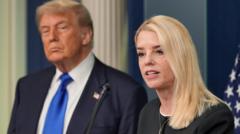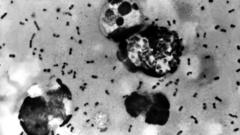The U.S. government's decision to leave the World Health Organization may disrupt decades of important initiatives aimed at safeguarding and studying the smallpox virus, raising significant global health concerns.
Trump's Withdrawal from WHO Poses Risks to Smallpox Management

Trump's Withdrawal from WHO Poses Risks to Smallpox Management
Health experts warn that the U.S. exit could undermine crucial smallpox safety measures and research efforts.
President Trump’s announcement to exit the World Health Organization (WHO) has raised alarms among health experts about the potential repercussions on global health security, specifically regarding the management of smallpox, a historically deadly virus. Experts fear this move could jeopardize the rigorous programs designed to protect against the virus, which has caused a staggering half a billion deaths over history.
The WHO has played a crucial role in overseeing the storage and research of smallpox virus remnants, held in secure facilities in the United States and Russia. These facilities operate under stringent biosafety regulations to prevent any accidental release or misuse. Health professionals argue that without the WHO's oversight, the risk of the virus leaking into the world could increase, as could the potential for secretive research by nations seeking biological weapons.
Dr. Thomas R. Frieden, former director of the Centers for Disease Control and Prevention (CDC), emphasized the urgency of transparency regarding smallpox research. He stated, "We need to open ourselves up to inspection," underscoring the importance of international accountability in managing such potent viruses.
In a recent contribution to the Infectious Diseases Society of America blog, Dartmouth medical professor Daniel R. Lucey warned that Trump's withdrawal could significantly disrupt smallpox virus storage, experimental research, and necessary safety inspections.
The WHO's eradication of smallpox from human populations in the late 20th century is celebrated as a significant health milestone, credited to global collaboration. However, the preservation of smallpox strains for future study, considered a safeguard against its potential return, now hangs in an uncertain balance with the U.S. retreat from international cooperation.
Both smallpox storage sites are classified at the highest biosafety level, indicating that they are prepared to handle some of the most dangerous pathogens while protecting public health. As the landscape of global health governance shifts, experts continue to advocate for vigilance and collaboration to prevent history from repeating itself with this formidable virus.
The WHO has played a crucial role in overseeing the storage and research of smallpox virus remnants, held in secure facilities in the United States and Russia. These facilities operate under stringent biosafety regulations to prevent any accidental release or misuse. Health professionals argue that without the WHO's oversight, the risk of the virus leaking into the world could increase, as could the potential for secretive research by nations seeking biological weapons.
Dr. Thomas R. Frieden, former director of the Centers for Disease Control and Prevention (CDC), emphasized the urgency of transparency regarding smallpox research. He stated, "We need to open ourselves up to inspection," underscoring the importance of international accountability in managing such potent viruses.
In a recent contribution to the Infectious Diseases Society of America blog, Dartmouth medical professor Daniel R. Lucey warned that Trump's withdrawal could significantly disrupt smallpox virus storage, experimental research, and necessary safety inspections.
The WHO's eradication of smallpox from human populations in the late 20th century is celebrated as a significant health milestone, credited to global collaboration. However, the preservation of smallpox strains for future study, considered a safeguard against its potential return, now hangs in an uncertain balance with the U.S. retreat from international cooperation.
Both smallpox storage sites are classified at the highest biosafety level, indicating that they are prepared to handle some of the most dangerous pathogens while protecting public health. As the landscape of global health governance shifts, experts continue to advocate for vigilance and collaboration to prevent history from repeating itself with this formidable virus.




















